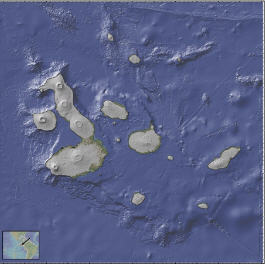How Have Changing Sea-Levels Influenced Evolution on the Galapagos Islands?

Writing in the Journal of Biogeography, Jason Ali and Jonathan Aitchison explore how fluctuating sea level changes over thousands of years impacted the island chain’s ecology.
They estimate that when the sea retreated, most recently 20,000 years ago, the water would have been 144m below its current level.
As a result, Santa Cruz, the island in the center of the archipelago, would have expanded, enveloping many of the smaller islands, while creating a series of shallow ‘land bridges’ between the volcanic outcroppings.
Such bridges explain the range and diversity of the islands' species, such as snakes, geckos and iguanas, which appear landlocked to modern eyes.
“As soon as I saw that that half the islands in the archipelago were sat on a single, shallow, submarine platform, I realized that the implications for biology could be significant,” said Dr. Ali.
“My geological knowledge told me that sea-level falls must have regularly re-connected the islands, and that this must have profoundly shaped the landlocked biota’s distribution, and very likely its composition.”
Media Contact
More Information:
http://eu.wiley.com/WileyCDA/PressRelease/pressReleaseId-110742.htmlAll latest news from the category: Earth Sciences
Earth Sciences (also referred to as Geosciences), which deals with basic issues surrounding our planet, plays a vital role in the area of energy and raw materials supply.
Earth Sciences comprises subjects such as geology, geography, geological informatics, paleontology, mineralogy, petrography, crystallography, geophysics, geodesy, glaciology, cartography, photogrammetry, meteorology and seismology, early-warning systems, earthquake research and polar research.
Newest articles

Webb captures top of iconic horsehead nebula in unprecedented detail
NASA’s James Webb Space Telescope has captured the sharpest infrared images to date of a zoomed-in portion of one of the most distinctive objects in our skies, the Horsehead Nebula….

Cost-effective, high-capacity, and cyclable lithium-ion battery cathodes
Charge-recharge cycling of lithium-superrich iron oxide, a cost-effective and high-capacity cathode for new-generation lithium-ion batteries, can be greatly improved by doping with readily available mineral elements. The energy capacity and…

Novel genetic plant regeneration approach
…without the application of phytohormones. Researchers develop a novel plant regeneration approach by modulating the expression of genes that control plant cell differentiation. For ages now, plants have been the…





















